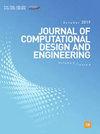基于虚拟现实的装配级增材制造决策框架设计涉及人的方面
IF 6.1
2区 工程技术
Q1 COMPUTER SCIENCE, INTERDISCIPLINARY APPLICATIONS
引用次数: 2
摘要
由于增材制造提供的设计自由度,装配设计的替代变体组合爆炸。为此,本文提出了一种基于虚拟现实的决策支持框架,用于提取AM路线制造的最佳装配设计。它特别解决了人类装配和增材制造之间的交集,因此结合了装配设计和使用公理设计理论的增材制造设计。为了实现这一点,进行了几个虚拟现实实验,让人类受试者组装零件。首先对二维表进行装配,根据装配时间、装配位移误差等非功能需求的独立性公理,确定装配时间、装配位移误差等非功能需求的独立性。然后,用三种装配设计变化的工业救生艇吊钩演示了这种方法。利用这些实验数据,基于信息公理(Information Axiom)从概率密度的角度评估组合的可能组合。该技术有效地识别出最有可能满足非功能需求的装配设计。据作者所知,这是第一次在决策过程的早期设计阶段以数字方式提取设计的人性化方面,并在详细设计阶段考虑优选装配设计。最后,该过程使用图形用户界面实现自动化,该界面包含了当前集成框架的实用性,使制造商能够选择最佳的装配设计。本文章由计算机程序翻译,如有差异,请以英文原文为准。
Virtual reality-based assembly-level design for additive manufacturing decision framework involving human aspects of design
There is a combinatorial explosion of alternative variants of an assembly design owing to the design freedom provided by Additive Manufacturing. In this regard, a novel Virtual Reality-based decision-support framework is presented herein for extracting the superior assembly design to be fabricated by AM route. It specifically addresses the intersection between human assembly and AM hence combining Design for Assembly, and Design for Additive Manufacturing using Axiomatic Design theory. Several Virtual Reality experiments were carried out to achieve this with human subjects assembling parts. At first, a 2D table is assembled, and the data are used to confirm the independence of nonfunctional requirements such as assembly time and assembly displacement error according to Independence Axiom. Then this approach is demonstrated on an industrial lifeboat hook with three assembly design variations. The data from these experiments are utilized to evaluate the possible combinations of the assembly in terms of probability density based on the Information Axiom. The technique effectively identifies the assembly design most likely to fulfill the nonfunctional requirements. To the authors’ best knowledge, this is the first study that numerically extracts the human aspect of design at an early design stage in the decision process and considers the selection of the superior assembly design in a detailed design stage. Finally, this process is automated using a graphical user interface, which embraces the practicality of the currently integrated framework and enables manufacturers to choose the best assembly design.
求助全文
通过发布文献求助,成功后即可免费获取论文全文。
去求助
来源期刊

Journal of Computational Design and Engineering
Computer Science-Human-Computer Interaction
CiteScore
7.70
自引率
20.40%
发文量
125
期刊介绍:
Journal of Computational Design and Engineering is an international journal that aims to provide academia and industry with a venue for rapid publication of research papers reporting innovative computational methods and applications to achieve a major breakthrough, practical improvements, and bold new research directions within a wide range of design and engineering:
• Theory and its progress in computational advancement for design and engineering
• Development of computational framework to support large scale design and engineering
• Interaction issues among human, designed artifacts, and systems
• Knowledge-intensive technologies for intelligent and sustainable systems
• Emerging technology and convergence of technology fields presented with convincing design examples
• Educational issues for academia, practitioners, and future generation
• Proposal on new research directions as well as survey and retrospectives on mature field.
 求助内容:
求助内容: 应助结果提醒方式:
应助结果提醒方式:


